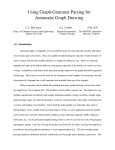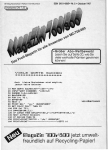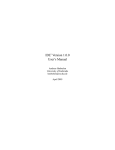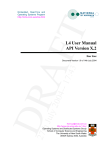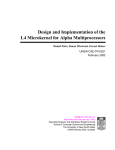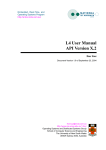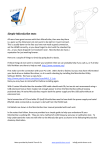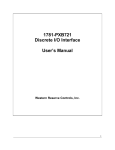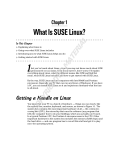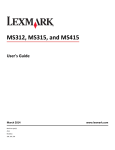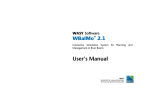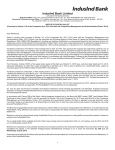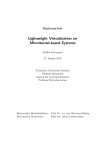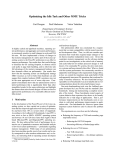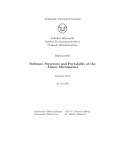Download L4 Introduction and L4 API
Transcript
The L4 Microkernel ➜ Developed and implemented on ix86 by Jochen Liedtke, GMD (Germany) ≈ 1992–95 (“Version 2”). ➜ Successor of Eumel (1979) and L3 (1987). ➜ Ongoing development by Liedtke at IBM Watson Research Center (1997–99), Uni Karlsruhe (1999–): L4Ka Version “X.2” ➜ Implementations at Dresden Uni of Technology and UNSW. cse/UNSW COMP3231 2002/S1 W12 P1 The L4 Microkernel ➜ Developed and implemented on ix86 by Jochen Liedtke, GMD (Germany) ≈ 1992–95 (“Version 2”). ➜ Successor of Eumel (1979) and L3 (1987). ➜ Ongoing development by Liedtke at IBM Watson Research Center (1997–99), Uni Karlsruhe (1999–): L4Ka Version “X.2” ➜ Implementations at Dresden Uni of Technology and UNSW. F EATURES ➜ ➜ ➜ ➜ ➜ ➜ 7(!) system calls (Version 2) recursive address spaces user-level page fault handlers user-level device drivers user-level scheduling real-time capable (sort-of) cse/UNSW COMP3231 2002/S1 W12 P1 L4 Implementations ➜ ix86: ➜ Liedtke’s kernel, 100% assembler, Versions 1–X ➜ Hohmut, Dresden, called Fiasco, C++, Version 2 ➜ Dannowski, L4Ka “hazelnut” kernel, C++, Version X ➜ L4Ka Team “pistachio” kernel, C++, portable, Version X.2 ➜ MIPS R4x00: ➜ Elphinstone, UNSW, 64-bit, assembler&C, Version 2 ➜ Calypso kernel by Chris Szmajda (VM management) ➜ UNSW pistachio port (Potts & Winwood), in progress ➜ Alpha: ➜ Schönberg (Dresden), 96, 64-bit, PALcode&C (rudimentary) ➜ Potts, Winwood (UNSW), completed, SMP, Version 2 ➜ UNSW pistachio port (Potts & Winwood), in progress ➜ StrongARM: ➜ L4Ka hazelnut kernel ➜ PowerPC:pistachio (LeVasser, Karlsruhe), partially complete ➜ IA-64: pistachio (Skoglund, Karlsruhe), partially complete ➜ SPARC: planned (UNSW) cse/UNSW COMP3231 2002/S1 W12 P2 L4 Implementation Example: MIPS H ISTORY ➜ ➜ ➜ ➜ ➜ Written by Kevin Elphinstone (UNSW PhD student), 1995–7 First 64-bit version of L4 Used in OS research projects at UNSW since 1996 Used in teaching at UNSW since 1997 New VM management (multiple page size, shared page tables, new PT structure) by Szmajda (calypso, not yet released) cse/UNSW COMP3231 2002/S1 W12 P3 L4 Implementation Example: MIPS H ISTORY ➜ ➜ ➜ ➜ ➜ Written by Kevin Elphinstone (UNSW PhD student), 1995–7 First 64-bit version of L4 Used in OS research projects at UNSW since 1996 Used in teaching at UNSW since 1997 New VM management (multiple page size, shared page tables, new PT structure) by Szmajda (calypso, not yet released) S TATISTICS (K ERNEL VERSION 79) ➜ ➜ ➜ ➜ ➜ 6k lines assembler source (*.S) 5k lines C source (*.c) 1.7k lines C and assembler header files (*.h) 80kB kernel text and static data 1MB kernel data (mostly TCBs and page tables) ➜ kernel footprint could be reduced to ≈ 200kB ➜ fast (details later) cse/UNSW COMP3231 2002/S1 W12 P3 Main L4 Abstractions threads: execution abstraction and UIDs tasks: address spaces and resources IPC: message-based communication, incl VM mappings flexpages: VM page abstraction, superpages clans and chiefs: task hierarchy for (arbitrary) security models pagers, excepters, preempters, interrupt handlers: exceptions • Mostly strict separation of: ➜ mechanisms (provided by kernel) and ➜ policy (implemented by user-level servers). • Minimality achieved by orthogonality of mechanisms. cse/UNSW COMP3231 2002/S1 W12 P4 L4 Threads • A thread is the basic active entity (execution and scheduling). • Threads communicate via message-passing IPC. • Each thread has ➜ a register set (IP, SP, user-visible registers, processor state) ➜ an associated task/address space ➜ a page fault handler (pager) this is a thread which receives page faults (via IPC) ➜ an exception handler (dependent on architecture) this is a thread which receives exceptions (via IPC) ➜ preempters (not implemented) tread which receives preemption messages ➜ scheduling parameters (priority, time slice) cse/UNSW COMP3231 2002/S1 W12 P5 Tasks • A task essentially provides an address space (plus a clan boundary). • An (active) task contains one or more (active) threads. • The number of threads in a task is fixed (128 on R4k). ➜ The full set of (128) threads is created with the task, ➜ all but one are inactive (i.e., they do nothing and consume no resources). ➜ further threads can be activated via a system call (lthread ex regs()) ➜ Model will change in future versions! • Upon system initialisation, the full set of tasks (2048 on R4k) is created, but in an inactive state. • A task has a chief (parent/owner). ➜ Chiefs will vanish in future versions! cse/UNSW COMP3231 2002/S1 W12 P6 IPC • Message-passing IPC provides communication between threads. • All IPC is ➜ synchronous (i.e., blocking), and ➜ unbuffered This is key to high IPC performance • IPC requires an agreement between sender and receiver (i.e., receiver must be expecting IPC, must provide buffers, etc.). ➜ supports in-line and out-of-line by-value data. ➜ supports map and grant VM operations for by-reference data. • Blocking can be limited by timeouts. Note the interaction between IPC and threads: • threads need efficient IPC to talk, • blocking IPC needs low-cost threads to be efficient. cse/UNSW COMP3231 2002/S1 W12 P7 Flexpages • Describe virtual memory regions for use in mapping operations. • Generalisation of pages by abstracting over page size. • Usually called fpages. P ROPERTIES ➜ ➜ ➜ ➜ size 2s, (≥ hardware page size), aligned to 2s kernel should try to map whole fpage as a single super-page partially populated fpages: an fpage refers to all mapped pages within the region designated by it. cse/UNSW COMP3231 2002/S1 W12 P8 Address Spaces Address spaces are recursively constructed from mappings into other address spaces: • A “magic” initial address space σ0 maps physical memory; • each address space (pager) can map portions of its own address space into another (cooperating) address space. cse/UNSW COMP3231 2002/S1 W12 P9 Address Spaces Address spaces are recursively constructed from mappings into other address spaces: • A “magic” initial address space σ0 maps physical memory; • each address space (pager) can map portions of its own address space into another (cooperating) address space. D ONE WITH THREE MAPPING PRIMITIVES Map: a page to receiver: sender retains page Grant: a page to receiver: sender loses page Flush: undoes a Map (removes page from receiver) cse/UNSW COMP3231 2002/S1 W12 P9 Granting ······ user A A A HH Y HH A A A grant HH H HH H A A A H F A A A A A A map A A A '$ f1 A A A f2 HH Y H HH H map HH H A A A HH A disk user X std pager &% cse/UNSW COMP3231 2002/S1 W12 P10 Clans & Chiefs Clans & Chiefs are a security mechanism for: • task control: define ownership of tasks ➜ a task creating another task becomes the chief of that task ➜ the set of tasks created by a chief is that chief’s clan ➜ task can be killed only ➀ directly by its chief ➁ indirectly when its chief is killed • communication control: restrict the flow of messages ➜ intra-clan messages are delivered directly ➜ inter-clan messages are redirected to chief ➜ chief can forward the message transparently Depth of hierarchy is limited (16 on MIPS). Note: Clans & chiefs will be replaced by a better model! cse/UNSW COMP3231 2002/S1 W12 P11 I NTER -C LAN IPC ' $ - ' $ ' MBB $ B B ' $ B & PP PP PP ? PP PP PP q % & % & & cse/UNSW % % COMP3231 2002/S1 W12 P12 Page Faults and Pagers • L4 maintains kernel page tables containing mappings explicitly established by user threads (via IPC). • On a page fault, the kernel invokes the thread’s pager by ➀ sending an IPC message to the pager on the faulter’s behalf ➁ catching the pager’s reply and continue the faulter Pager’s is expected to send a mapping for the missing page. client RPC pager page fault L4 cse/UNSW COMP3231 2002/S1 W12 P13 Exceptions and Excepters L4/MIPS EXCEPTION HANDLING Totally analogous to page faults: • Each thread has an excepter • If a thread triggers an exception, the kernel invokes the thread’s excepter by: ➀ sending an IPC message to the pager on the faulter’s behalf, ➁ catching the pager’s reply and continue the faulter. • The excepter may chose not to reply, leaving the excepting thread blocked forever. cse/UNSW COMP3231 2002/S1 W12 P14 L4/ IX 86 EXCEPTION HANDLING Virtualisation of hardware: • A thread installs its own interrupt vector, using (kernel-emulated) processor features. The kernel handles some exceptions internally (TLB miss, system call). cse/UNSW COMP3231 2002/S1 W12 P15 Preemptions and Preempters • Basic idea: ➜ treat a preemptions like a page fault, i.e., a time faults, ➜ have a preempter as a time-fault handler, ➜ preempter is invoked via IPC. • Model is, at present, not matured, and preemtpers are not implemented in any L4 version. cse/UNSW COMP3231 2002/S1 W12 P16 Interrupts and Interrupt Handlers • Each hardware interrupt is modelled as a virtual (hardware) thread. • (At most) one user-level interrupt-handler thread is associated with each hardware interrupt. • If an interrupt occurs, the kernel generates an IPC from the interrupt thread to the interrupt handler. • The interrupt handler is in general (part of) a device driver. ➜ It will need access to device registers. ➜ Done via a special mapping protocol of the root pager. Kernel handles some interrupts internally (e.g., timer). cse/UNSW COMP3231 2002/S1 W12 P17 Device Interfaces • Devices are controlled via special device registers, typically: ? status register, to obtain device status, ? control register, to send commands to device status and control registers are at the same address, ? data register(s) to pass data/command parameters. • Number of registers is normally small, data and parameter buffers are passed in memory, address specified in data registers • Device registers are either memory mapped or accessed via I/O instructions • Devices access only physical memory, i.e. bypass the MMU. cse/UNSW COMP3231 2002/S1 W12 P18 Device Driver • Interface between hardware (device controller) and OS. • Processes OS device requests and controls device by writing to data & command registers. • Monitors device by reading status & data registers and handling device interrupts. • Transfers data between OS buffers and device. cse/UNSW COMP3231 2002/S1 W12 P19 L4 device driver • Runs at user level. • Has mappings for device registers (MIPS) and physical memory. • Typically consists of top half and bottom half. cse/UNSW COMP3231 2002/S1 W12 P20 L4 device driver • Runs at user level. • Has mappings for device registers (MIPS) and physical memory. • Typically consists of top half and bottom half. TOP HALF HANDLER processes device interrupts: ➜ ➜ ➜ ➜ ➜ receive L4 interrupt IPC, check success (status register), make data available (copying or mapping), initiate next request (if one), notify/reply to user (IPC). cse/UNSW COMP3231 2002/S1 W12 P20 L4 device driver • Runs at user level. • Has mappings for device registers (MIPS) and physical memory. • Typically consists of top half and bottom half. TOP HALF HANDLER processes device interrupts: ➜ ➜ ➜ ➜ ➜ receive L4 interrupt IPC, check success (status register), make data available (copying or mapping), initiate next request (if one), notify/reply to user (IPC). B OTTOM HALF HANDLER processes user requests: ➜ initiate I/O (set up parameter buffer, write device registers) or queue request if device busy, ➜ reply to user (if asynchronous) cse/UNSW COMP3231 2002/S1 W12 P20 L4 device driver... • Top half must be fast (to avoid missing interrupts): ➜ runs at high priority, ➜ generally runs with interrupts disabled, ➜ does minimal amount of work, ➜ longer tasks left to to top half (copying buffers, replying to user). • Concurrency control required between top and bottom half. • Top half must not be blocked by bottom half. cse/UNSW COMP3231 2002/S1 W12 P21 L4-Based OS Design client devices tty SCSI client OS pager other OS excpt handler syscall handler sub system L4 cse/UNSW COMP3231 2002/S1 W12 P22 OS Structure • OS server is chief of client processes. • Client’s “system calls” are library stubs performing RPC to OS server. • “OS” may consist of many server threads in same or separate tasks. • OS server may redirect client requests to other servers ➜ within OS server task, ➜ outside OS server task. • Clans & chiefs mechanism: ➜ prevents direct client access to separate servers tasks, ➜ supports easy redirection of “system call” RPC. cse/UNSW COMP3231 2002/S1 W12 P23 The L4 Interface • The L4 Reference Manual [EHL97] defines the L4 ABI: ➜ making maximal use of registers ➜ assembler interface ➜ very architecture-specific • libl4 provides a C API: ➜ still somewhat architecture specific (e.g. size of register message) ➜ interface is defined in header files in http:/˜cs9242/include/, $L4/include/l4/ ➜ documented in Unix man pages http:/˜cs9242/man/, $L4/man/man2/ • Usage is explained in the L4 User Manual [AH98] cse/UNSW COMP3231 2002/S1 W12 P24 L4 System Calls ➀ ipc() ➜ Message passing, combining send and receive ➁ fpage unmap() ➜ Revoke mappings ➂ id nearest() ➜ Determination own and target TID ➃ task new() ➜ Create/delete task/address space ➄ lthread ex regs() ➜ Create/manipulate thread ➅ thread switch() ➜ Explicit time-slice donation ➆ thread schedule() ➜ Setting/enquiring scheduling parameters cse/UNSW COMP3231 2002/S1 W12 P25 IPC System Call Overview Variants of syscall accessible via separate C bindings C LIENT FUNCTIONS ➜ send() send a message (blocking) to a specific thread ➜ receive() “closed” receive from specific sender — includes sleeping (if specify invalid sender) ➜ wait() “open” receive from any thread (incl. interrupt) ➜ call() send & wait for reply — usual “RPC” operation ➜ reply and wait() send & wait for any message — typical server operation ➜ send deceiving() like send() but substituting sender ID ➜ reply deceiving and wait() similar cse/UNSW COMP3231 2002/S1 W12 P26 C BINDINGS FOR CHIEFS • Support transparent forwarding by chief: ➜ chief send() identical to send deceiving ➜ chief wait() like wait() but returns intended destination ➜ chief receive() like receive() but returns intended destination ➜ chief call() like call(); substitutes sender & returns intended destination ➜ chief reply and wait() like reply deceiving and wait(); returns intended destination cse/UNSW COMP3231 2002/S1 W12 P27 Deceiving IPC C LANS & CHIEFS MECHANISM supported by deceiving: • If “deceit” bit is set by sender, L4 will deliver the message with sender-specified virtual sender ID • The receiver is alerted by the deceit bit • Deceiving only works if direction preserving ? real sender must be along the redirection chain from the virtual sender to the receiver, i.e.: ∗ message goes out of clan & virtual sender ID is within clan, or ∗ message goes to subclan & virtual sender ID is outside clan. • Supports transparent inter-clan IPC interception cse/UNSW COMP3231 2002/S1 W12 P28 Example: Send Call int l4 mips ipc send (l4 threadid t dest, ID of dest. thread const void *snd msg, msg descriptor l4 ipc reg msg t *snd reg, initial part of msg l4 timeout t timeout, timeout spec l4 msgdope t *result) result code Message is divided into two parts: • initial part (snd reg, 64 bytes on R4k) is passed in registers • remainder (possibly empty) is passed as a by-value string Operation will not block longer than indicated by timeout • can be 0 or ∞. cse/UNSW COMP3231 2002/S1 W12 P29 Example: Receive Call int l4 mips ipc receive (l4 threadid t src, ID of sender const void *rcv msg, msg descriptor l4 ipc reg msg t *rcv reg, initial part of msg l4 timeout t timeout, timeout spec l4 msgdope t *result) result code • Will only accept message from specified sender. • result contains result code and description of received message (i.e. in-line vs. out-of-line data). cse/UNSW COMP3231 2002/S1 W12 P30 L4 IPC Messages T WO KINDS OF MESSAGE PARAMETERS : ➀ snd reg or rcv reg: in-register (“short”) part of message (first 8 words on MIPS R4k) ➁ snd msg or rcv msg: in-memory (“long”) part of message cse/UNSW COMP3231 2002/S1 W12 P31 L4 IPC Messages T WO KINDS OF MESSAGE PARAMETERS : ➀ snd reg or rcv reg: in-register (“short”) part of message (first 8 words on MIPS R4k) ➁ snd msg or rcv msg: in-memory (“long”) part of message M ESSAGES CONTAIN 3 KINDS OF DATA : ➀ by-value in-line data (directly in registers or message buffer) ➁ by-value “string” (out-of-line) data (message buffer contains pointer to data) ➂ by-reference “fpages” (describing mappings) cse/UNSW COMP3231 2002/S1 W12 P31 Register message format • Registers (s0 . . . s7 on MIPS R4k) contain: ? some (possibly zero) 2-word fpage descriptors, ? followed by data fpage descriptors by-value data ? presence of fpages is indicated by the m-bit in snd msg or rcv msg. ? fpage processing stops if invalid fpage descriptor found ? remainder (or all) of register data is simply copied • Size is specified in l4/ipc.h:l4 ipc reg msg t. cse/UNSW COMP3231 2002/S1 W12 P32 Send message descriptor format F ORMAT OF snd msg PARAMETER : *snd msg/4(62) md ➜ *snd msg/4 — message descriptor address = 0: short message (no memory data) 6= 0: address of message descriptor ➜ m — mapping bit = 0: by-value send operation (no mappings) 6= 0: by-reference (mapping) send operation ➜ beginning of message string contains fpage descriptors ➜ d — deceiving bit: lie about sender turned on automatically by using deceiving send binding. cse/UNSW COMP3231 2002/S1 W12 P33 Receive message descriptor format (MIPS) F ORMAT OF msg rcv PARAMETER : *rcv msg/4(62) m∼ ➜ m — mapping bit m = 0: *rec msg= 0: receive register data only (no mappings) *rec msg6= 0: message descriptor address ➜ first 8 words of message are in registers ➜ rest as specified in message buffer ➜ may accept mappings (if receive fpage option is used) m = 1: fpage receive operation ➜ *rcv msg is not a pointer ➜ contains the fpage describing the mapping window cse/UNSW COMP3231 2002/S1 W12 P34 Memory message format message header fpage descriptors by-value data string dopes • Fpages are expected only if ➜ ➜ ➜ ➜ ➜ the m-bit is set in the send message descriptor, and register data starts with a valid fpage descriptor. Fpage processing stops if invalid fpage descriptor found. Fpages are only recognised in register part of message (MIPS) all data is copied to receive (incl. fpage descriptors) • Out-of-line data (“strings”) ➜ described by “dopes”, immediately after in-line data . cse/UNSW COMP3231 2002/S1 W12 P35 Message format: Logical snd_msg msg hdr fpages in-line string string string dopes string cse/UNSW COMP3231 2002/S1 W12 P36 Message format: Physical registers: fpages in-line part 1 snd_msg msg hdr in-line part 2 string dopes string string string cse/UNSW COMP3231 2002/S1 W12 P37 Message header format DATA STRUCTURE L 4/ T Y P E S . H : L 4 M S G H D R T w2 w1 w0 0(32) 0(32) words(19) words(19) str(5) ∼(8) str(5) ∼(8) fpage(64) w0 receive fpage: describes how to map any incoming fpages w1 message size dope: specifies the total buffer space available words: size of buffer in words (total for fpages and in-line data) strings: number of string dopes w2 message send dope: buffer space used on sending i.e., buffer size used (words) and string dopes used (strings) must be less than or equal specifications of message size dope • Note: specified buffer/message size is in addition to registers cse/UNSW COMP3231 2002/S1 W12 P38 String dope format DATA STRUCTURE L 4/ T Y P E S . H : L 4 S T R D O P E T w3 w2 w1 w0 w0 w1 w2 w3 *rcv string(64) rcv string size(64) *snd string(64) snd string size(64) size in bytes of string to be sent address of string to be sent size in bytes of buffer for string to be received address of buffer for string to be received cse/UNSW COMP3231 2002/S1 W12 P39 IPC Result Status MESSAGE DOPE returns status word: 0(32) words(19) str(5) cc(8) words: size in words of in-line data received • in addition to registers str: number of strings received • in buffers pointed to by string dopes • dopes contained in message header cc: condition code cse/UNSW COMP3231 2002/S1 W12 P40 IPC Result Condition Code C ONDITION CODE FORMAT: ec(4) i r md ec error code: ec6= 0 ⇒ IPC failed ➜ result codes in manual ➜ frequent reason: Cut message — receiver’s buffer was too small, not enough strings, etc. ➜ Note: this value is also delivered as C return value m map bit: m = 1 ⇒ fpages were received Other bits are for clans and chiefs, consult the manual. cse/UNSW COMP3231 2002/S1 W12 P41 IPC Timeout Specifications • An IPC operation specifies 4 timeout values: mr (8) ms(8) pr (4) ps(4) es(4) er (4) mr , er : receive timeout is mr 415−er µs ms, es: send timeout is ms415−es µs pr : receive page fault timeout is 415−pr µs ps: send page fault timeout is 415−ps µs ➜ e = 0 or p = 0 mean ∞, i.e., no timeout ➜ m = 0 & e > 0 mean 0, i.e., never block) ➜ p = 15 means 0, i.e., fail on page fault cse/UNSW COMP3231 2002/S1 W12 P42 Timeouts... • IPC timeouts can be specified between 1µs and 19h • page fault timeouts can be specified between 4µs (1ms) and 256s • actual timeout resolution is more coarse ➜ 1ms timeout resolution on MIPS • Data structure l4/types.h:l4 timeout t, L4 IPC TIMEOUT() • Utilities (time.h): void l4_mips_encode_timeout( dword_t msecs, byte_t *mant, byte_t *exp, byte_t round); dword_t l4_mips_decode_timeout(byte_t mant, byte_t exp); cse/UNSW COMP3231 2002/S1 W12 P43 Specification of Mappings • Source and destination specified as fpages. • Sender specifies a set of fpages which are to be mapped/granted to the receiver. • Receiver specifies the receive window ➜ kernel will not map outside this window! cse/UNSW COMP3231 2002/S1 W12 P44 Specification of Mappings • Source and destination specified as fpages. • Sender specifies a set of fpages which are to be mapped/granted to the receiver. • Receiver specifies the receive window ➜ kernel will not map outside this window! FPAGE REPRESENTATION (MIPS) base/4096(52) 0(3) s(7) ˜˜ • Data structure l4/types.h:l4 fpage t. • MIPS kernel presently only supports 4kB pages • Bigger (send) fpages are handled by mapping individual pages cse/UNSW COMP3231 2002/S1 W12 P44 Fpage Mapping • Send and receive fpages may be of different size: ➜ page fault receive fpage covers full address space, ➜ there may be several send fpage, but only one receive fpage, ➜ fpage may need to be mapped at different addresses in sender and receiver (e.g., on page fault). cse/UNSW COMP3231 2002/S1 W12 P45 Fpage Mapping • Send and receive fpages may be of different size: ➜ page fault receive fpage covers full address space, ➜ there may be several send fpage, but only one receive fpage, ➜ fpage may need to be mapped at different addresses in sender and receiver (e.g., on page fault). • Need ability to specify where an fpage gets mapped • Send fpage is accompanied with a hotspot address (send base) ➜ Determines mapping address if receive fpage is big enough. cse/UNSW COMP3231 2002/S1 W12 P45 Fpage Mapping • Send and receive fpages may be of different size: ➜ page fault receive fpage covers full address space, ➜ there may be several send fpage, but only one receive fpage, ➜ fpage may need to be mapped at different addresses in sender and receiver (e.g., on page fault). • Need ability to specify where an fpage gets mapped • Send fpage is accompanied with a hotspot address (send base) ➜ Determines mapping address if receive fpage is big enough. S END FPAGE INFORMATION w1 w0 snd fpage(62) snd base(64) wg w: write-permission bit, unset ⇒ fpage will be mapped read-only g: grant bit, set ⇒ fpage will be granted cse/UNSW COMP3231 2002/S1 W12 P45 Fpage Mapping Rules • Rules for disambiguating fpage mapping: ? Hotspot address is taken modulo receive fpage size. ➜ Uniquely determines a page in the receiver’s address space which will receive a mapping. ? Hotspot address is also taken modulo send fpage size. ➜ Uniquely determines a page in the send fpage which will be mapped. • In other words, the smaller fpage is mapped to/from the larger one so that: ➜ it is aligned according to its size, and ➜ it contains the hot spot. cse/UNSW COMP3231 2002/S1 W12 P46 Fpage Mapping Examples s=10 b=5 s=12 b=0 h=2 x 210 + offset s=12 b=0 s=10 b=5 h=2 x 210 + offset cse/UNSW COMP3231 2002/S1 W12 P47 Formal Fpage Mapping Rules • Sender specifies fpage as b, s: fpage [b × 2s, (b + 1) × 2s], • Sender specifies hotspot h, • Receiver specifies fpage as b0, s0: fpage 0 s0 0 s0 [b × 2 , (b + 1) × 2 ]. s = s0: mapping is b × 2s 7→ b0 × 2s hot spot specification is not needed s < s0: mapping is b × 2s 7→ b0[63,s0]h[s0−1,s]0(s) sender’s fpage is aligned around hot spot 0 0 0 s s > s : mapping is b[63,s]h[s−1,s0]0(s0) 7→ b × 2 receiver’s fpage is aligned around hot spot s s0 • Note: Only h mod max(2 , 2 ) is relevant. cse/UNSW COMP3231 2002/S1 W12 P48 Fpage Notes • Page fault IPC (manufactured by kernel) specifies whole address space for receiver (b0 = 0, s0 = 64) • Present MIPS implementation only uses smallest hardware page size (s = 12), but that is transparent to user ➜ Changed in next release. • Present MIPS implementation does not support granting ➜ Changed in next release. • An attempt to map over an existing mapping is silently ignored (except if the mappings only differ in the write permission). This is a bug in all present L4 implementations! ➜ Changed in next release. cse/UNSW COMP3231 2002/S1 W12 P49 Revoke Mappings: fpage unmap() • Unmaps pages directly or indirectly mapped from caller’s address space. • Unmapping may be: ➜ partial (revert to read-only, “remap”), or ➜ complete (pages vanish from other address spaces, “flush”). • The fpage argument defines a region in the caller’s address space. • All pages within that region which are mapped into other address spaces will be remapped or flushed. • Mappings in the caller’s address space are ➜ unaffected (“other”), or ➜ also unmapped (“all”). cse/UNSW COMP3231 2002/S1 W12 P50 Obtain Thread IDs: id nearest System Call • Returns the ID of the thread which would really receive a message sent to a specified destination thread. • Also returns a type field, indicating the direction of the IPC with respect to the clan boundary. • If destination is: inside own clan: returns destination thread ID, type = same; outside own clan: returns own chief’s ID, type = outer; in subclan of own clan: returns ID of chief (within own clan) of subclan, type = inner; nil: returns own thread ID. cse/UNSW COMP3231 2002/S1 W12 P51 Task Creation and Deletion: task new() • • • • System has fixed number of tasks, initially all inactive. Inactive task is essentially a capability to create an active one. Task is active iff it has a valid pager. task new deletes an (active or inactive) task and creates a new one (with task same number but different version, hence different ID). • New task can be ➜ active: syscall parameters specify start address, stack pointer, pager, exception handler, scheduling priority; ➜ initially runs single thread (lthread 0); ➜ inactive: does not consume any resources, can optionally be donated to new chief. cse/UNSW COMP3231 2002/S1 W12 P52 Details of task new Operation • • • • • Donation of inactive tasks allows passing of creation right. Deleting an inactive task does not affect version number. Deleting a task implicitly deletes all tasks in its clan or subclans. Only a task’s chief can execute a task new syscall for it Exception (MIPS): Anyone can call task new for a task which has never been active. ➜ Means of allocating task creation rights at system startup. cse/UNSW COMP3231 2002/S1 W12 P53 Thread Manipulation: lthread ex regs() • Task has a fixed number (128) of threads, initially all but one inactive. • Thread is activated by supplying a valid IP and SP. ➜ Thread inherits pager, excepter from activating thread. • lthread ex regs() sets new and returns previous values for instruction pointer (IP), stack pointer (SP), exception handler, pager. • Supplying invalid value (-1) to any of those retains original setting. Can be used for: ➜ performing a user-level thread switch (exchanging registers of running thread with saved ones); ➜ saving thread’s context (by supplying only invalid parameters). • Call terminates any pending or ongoing IPC. • Note: A thread cannot be “deleted”, only blocked. cse/UNSW COMP3231 2002/S1 W12 P54 Release CPU: thread switch() The calling thread voluntarily releases the CPU. • May specify another thread to continue immediately (“time slice donation”). ➜ Destination thread gets remaining time slice “for free”. ➜ Normal scheduling taken at expiry. • May yield CPU by not specifying valid destination thread. ➜ Remaining time thread is forfeit. ➜ Normal scheduling action taken immediately (possibly re-scheduling caller thread). cse/UNSW COMP3231 2002/S1 W12 P55 Scheduling Parameters: thread schedule() • Allows setting/inquiring the priority and timeslice length of a thread. • Also returns thread state (running/IPC-ing/dead). ➜ Partially implemented on MIPS. • Scheduling parameters can only be changed for a thread running at a lower priority than the caller’s maximum controlled priority (MCP). • If setting priority, cannot exceed caller’s MCP. • MCP is task attribute, specified in task create system call (child MCP cannot exceed parent’s). cse/UNSW COMP3231 2002/S1 W12 P56 Task and thread management • Management of task and thread IDs is left to user-level code. • L4’s task create and lthread ex regs system calls will happily destroy running tasks/threads if requested to do so. ⇒ It is up to the user code (i.e., OS server) to manage them properly. cse/UNSW COMP3231 2002/S1 W12 P57 L4 Scheduling • Every L4 thread has a timeslice length and a priority. • These are: ➜ inherited from parent, ➜ changeable via thread schedule(). • L4 implements hard priorities: ➜ scheduler will always select highest priority runable thread, ➜ within priority scheduler uses round-robin. cse/UNSW COMP3231 2002/S1 W12 P58 User-level scheduling in L4 Two ways to control scheduling: • Can use controller thread (with high MCP): ➜ uses thread schedule to manipulate other threads, ➜ controlled threads run with zero MCP. • Can use user-level scheduler thread running at highest priority: ➜ L4 will always schedule this scheduler thread, ➜ Scheduler thread uses thread switch() to give a time slice to some thread. • Preempters (unimplemented) would be used to inform scheduler of premptions. Obvioulsy combinations of these are possible. cse/UNSW COMP3231 2002/S1 W12 P59 The Root Pager σ0 • σ0 is the initial address space. • σ0 contains a mapping for each available frame of physical memory. • σ0 is also a pager (and chief) for original servers (tasks contained in boot image and marked as automatically run). • σ0 maps any frame (writable) to the first task requesting it (and ignores any further requests for the same frame). • Pages can be requested implicitly (by touching) or explicitly (by RPC according to paging protocol). ➜ First job of “OS personality” is to request all available frames. ➜ Server has then control over memory. • Some special pages are used for kernel information page and memory-mapping devices. • On MIPS σ0 runs in kernel space for no good reason. cse/UNSW COMP3231 2002/S1 W12 P60 Kernel information page • Lives in kernel reserved space • Mapped by σ0 upon requesting a particular invalid page (address -3 on MIPS). • Mapped read-only to anyone requesting it at any time. • Contains information about L4 and machine: ➜ L4 version etc, ➜ size of physical memory, ➜ size and address of L4 reserved memory, ➜ millisecond real-time clock, ➜ address of DIT header page (MIPS). cse/UNSW COMP3231 2002/S1 W12 P61 DIT header page (MIPS) • • • • Lives in kernel reserved space. Address is contained in kernel info page. Mapped read-only to anyone requesting it at any time. Contains for each file in the boot image: ➜ name, ➜ size and location in physical memory, ➜ entrypoint address (zero if not executable image), ➜ flag indicating whether it’s to be started by σ0. cse/UNSW COMP3231 2002/S1 W12 P62 Devices (MIPS) • Are memory-mapped to addresses outside RAM range. • Device pages are mapped upon requesting a particular invalid page with page address as second parameter. • Mapped writable and uncacheable to anyone requesting it at any time. ➜ Note: only tasks in σ0’s clan can IPC directly to σ0! • “Device” mappings within RAM are used for DMA-able memory. • Present MIPS σ0 does not check whether address really refers to a device. • Cacheability attribute is passed on when mapping to subtasks ➜ supports device drivers not directly in σ0’s clan. cse/UNSW COMP3231 2002/S1 W12 P63 Bootstrap (MIPS Specific) Boot image: header L4 initial server... other stuff On boot: ➀ Load image into RAM. ➁ L4 bootstrap starts σ0 as first task (in kernel mode). ➂ σ0 starts all initial servers (as user tasks) registering as their pager, exception handler (and chief). Initial servers are marked as such in boot image set up by DIT (“downloadable image tool”). cse/UNSW COMP3231 2002/S1 W12 P64 OS Startup Code ➀ Register itself for all free interrupts. ➁ Grab all memory from σ0 (without interfering with other initial tasks). ➂ Set up data structures for memory management: ➜ reserved space for own tables, ➜ free lists/frame table/page tables for client memory. ➃ Grab all (inactive) tasks. ➄ Start device drivers (maybe separate initial server tasks). ➜ Drivers map device pages. ➅ Start other server threads (if multi-server implementation). ➆ Set up data structures for services (TCBs, file system, ...) ➇ Set up task management. ➈ Start up initial “user” task(s). ➉ Possibly donate tasks to subtasks. cse/UNSW COMP3231 2002/S1 W12 P65 Device drivers • • • • • maps device registers (device mapping from σ0) maps uncached RAM (device mapping from σ0) sets up interrupt handler thread for device initialises device (by writing to device registers) process user requests and device interrupts cse/UNSW COMP3231 2002/S1 W12 P66 Implication of server architecture “OS” is just a user-level L4 task. ⇒ OS can be interrupted & unscheduled. ⇒ Need concurrency control on all OS data structures! cse/UNSW COMP3231 2002/S1 W12 P67 What to run first? OS always ➜ handles a client request, or ➜ waits for a client request Q: Where does it get the clients from? cse/UNSW COMP3231 2002/S1 W12 P68 What to run first? OS always ➜ handles a client request, or ➜ waits for a client request Q: Where does it get the clients from? A: define your own startup convention, e.g.: • OS starts up first non-initial server executable in boot image, • First non-executable item in boot image contains list of initial client tasks, • OS looks for program of a certain name in boot image. cse/UNSW COMP3231 2002/S1 W12 P68 Where’s the OS? How does a client know where to send syscall RPCs? ➀ First action of new task could be an “open receive”: ➜ parent sends message (thereby disclosing its identity) ➜ hide in startup code (“crt0”) ➁ Client could send all system call RPCs to σ0: ➜ clans & chiefs mechanism ensures that parent receives message, ➜ parent replies by “deceiving send” pretending to be σ0. ⇒ It’s a matter of convention. cse/UNSW COMP3231 2002/S1 W12 P69 References [AH98] Alan Au and Gernot Heiser. L4 User Manual. School Comp. Sci. & Engin., University NSW, Sydney 2052, Australia, Jan 1998. UNSW-CSE-TR-9801. Latest version available from http://www.cse.unsw.edu.au/˜disy/L4/. [EHL97] Kevin Elphinstone, Gernot Heiser, and Jochen Liedtke. L4 Reference Manual: MIPS R4x00. School Comp. Sci. & Engin., University NSW, Sydney 2052, Australia, Dec 1997. UNSW-CSE-TR-9709. Latest version available from http://www.cse.unsw.edu.au/˜disy/L4/. cse/UNSW COMP3231 2002/S1 W12 P70
















































































